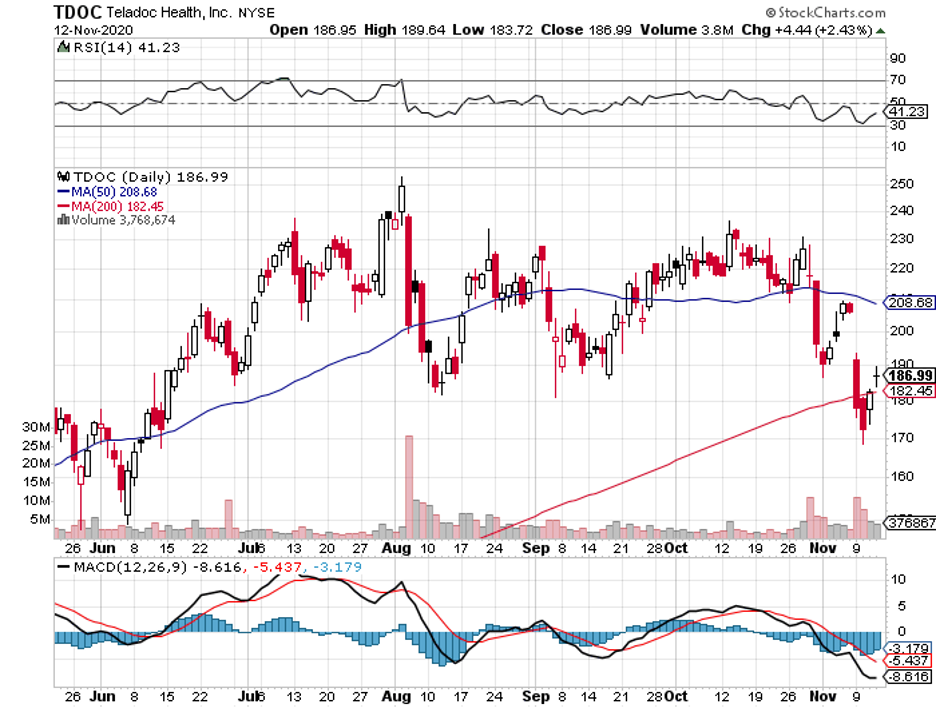Digital health was a struggling sector before COVID-19, but the pandemic changed the game, driving customers and even providers to embrace digital health solutions.
As expected, frontrunner Teladoc Health (TDOC) surfaced as a major beneficiary of this booming industry, reporting a record high in the number of virtual care visits during the ongoing health and financial crisis.
While there are concerns that these rewards could be fleeting, COVID-19 appears to have contributed longer-lasting changes, particularly in consumer behavior.
More and more users are opting for digital health solutions, with total virtual care visits up by 206% to hit 2.8 million in the third quarter of 2020 alone.
A noticeable change in Teladoc’s portfolio is the diversity of diseases they handle.
Previously accounting for only a third of its total care visits in 2019, non-infectious conditions like hypertension, depression, anxiety, and back pain now account for half.
As for the virtual care visits for dermatology and behavioral health in their business-to-business transactions, the company enjoyed a 500% boost year over year.
For context, the total number of virtual visits to Teladoc in 2019 was only 4.1 million.
Since the year 2020 started, though, the company has already recorded almost twice that number at 7.6 million—and the fourth quarter is projected to become its best-performing period yet.
The shift was also evident in the third-quarter earnings report of Teladoc, which showed that the company’s top line jumped by 109% year over year to reach $289 million.
This marks the company’s highest quarterly top-line growth rate.
In fact, this growth rate exceeded even the company's expectations.
When Teladoc released its second-quarter earnings, its Q3 projections were only somewhere between $275 million and $285 million.
As the number of COVID-19 cases continues to climb, it is highly possible that the company will once again deliver much better results than the forecasted numbers in the fourth quarter.
In terms of its fourth-quarter projections, Teladoc is expected to reach roughly 3 million virtual visits in the last months of 2020.
The conservative estimate for Teladoc’s total virtual visits this year is at 10 million.
So far, Teladoc shares are up 133% year-to-date, with the company expected to cross the $1 billion revenue mark in 2020—an almost 100% increase from its 2019 projection.
In terms of future growth, Teladoc recently completed an $18.5 billion mega-merger with Livongo Health (LVGO), making it a one-stop-shop for every virtual care need.
As a combined unit, the Teladoc-Livongo partnership is hailed as the next-generation virtual care provider. Simply put, this newly formed company is the future of the healthcare industry in America.
This means that while Teladoc has more than doubled this 2020, the stock is still expected to continue soaring thanks to its recent merger with Livongo.
Here’s a brief background of Livongo.
This company gathers data and sends reminders to its users suffering from chronic diseases to encourage them to implement lifestyle and even behavioral changes that would improve their health.
Prior to its cash-and-stock merger with Teladoc, Livongo was doubling its membership, particularly among diabetes patients.
This deal is anticipated to elevate virtual care and push Teladoc front and center of the $121 billion digital health market in the United States alone—a number that is projected to grow at a rate of 16.9% until 2025.
Needless to say, Teladoc has set itself up to control a huge part of that total value.
So far, the most notable competitors of Teladoc in this space are technology giants like Google (GOOG) via its parent company Alphabet (GOOGL) and Apple (AAPL).
With all the opportunities and even with the challenges of new competitors in the market, Teladoc remains the leader in this explosive digital health industry, making it extremely attractive for investors to ignore.
Looking at its risk-reward proposition, the company is clearly a solid growth pick.
After all, telemedicine offers a long-term win-win-win situation for everyone in the healthcare industry.
It is a win for doctors because they can see more patients.
It’s a win for patients because they get to see doctors with ease and convenience.
Finally, it is a win for insurance agencies because they generally pay lower bills for virtual visits.



